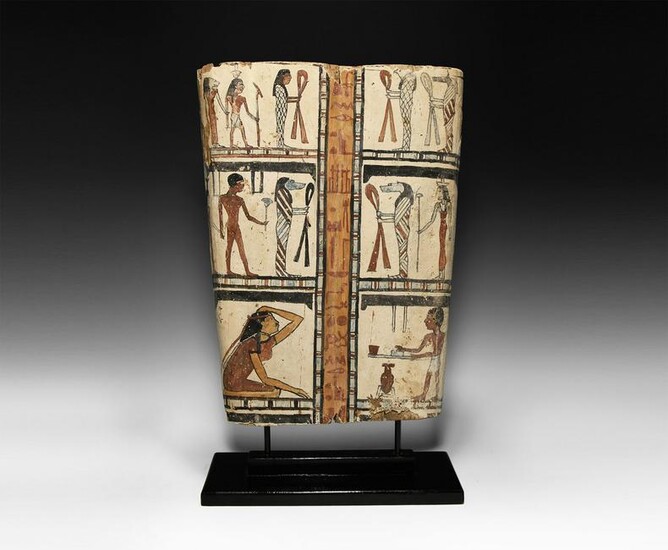Egyptian Painted Cartonnage with Figural Panels
Ptolemaic Period, 332-30 BC. A painted cartonnage mummy panel, rectangular with curved sides, a vertical central column of hieroglyphs with a prayer of invocation to Osiris, god of the dead, flanked by six painted panels, three each side, bearing human and deity figures including a mummiform swathed male figure followed by the god Nefertum with lotus headdress holding a tall was sceptre and the lioness-headed goddess Maahes; a mummiform swathed figure of hawk-headed Horus followed by jackal-headed Anubis; a male figure holding a tall stemmed lotus flower preceded by a feline-headed swathed deity; a similar feline deity followed by the goddess Isis or Nephthys her hieroglyph indistinct on her head and holding a tall sceptre; a kneeling female professional mourner casting dirt on her head and a kilted male figure holding an incense burner on a tray above a water jar on a stand; the five mummiform swathed figures hold the looped sa sign of protection; mounted on a custom-made display stand. See Corbelli, J.A., The Art of Death in Graeco-Roman Egypt, Shire Publications Ltd, 2006, for discussion; see Fluck, C. et al., Egypt faith after the Pharaohs, The British Museum, London, 2015, for discussion of late funerary practices; see Walker, S, and Higgs, P., Cleopatra of Egypt: from History To Myth, The British Museum Press, London, 2001, for general discussion; see Walker, S. and Bierbrier, M., Ancient Faces: Mummy Portraits from Roman Egypt, The British Museum Press, London, 1997, for discussion of Ptolemaic burial practices. 1.8 kg total, 56cm including stand (22"). Property of a Middlesex lady; acquired on the London art market in 2007; formerly in a 1970s private collection. The Ptolemaic dynasty was the last to rule over ancient Egypt. The ruling family were of Macedonian Greek origin and the ?????????? ???????? (Ptolemaic kingdom) was founded in 305 BC by Ptolemy I Soter, a companion of Alexander the Great. The kingdom endured until the death of the last monarch, Cleopatra, in 30 BC. The dynasty ruled Egypt for longer than any predecessor. The ancient Egyptians preserved their bodies intact in preparation for the afterlife, a practice which was continued by the Ptolemies, and afterwards by the Romans who ruled Egypt after the death of Cleopatra. While standards of mummification declined during this period, the outer coverings used to contain the corpse were often elaborately constructed and decorated. Cartonnage was usually manufactured by fusing layers of papyrus and/or linen together using gesso as an adhesive. The medium could be modelled according to the artist's wishes and once dry it could be painted or gilded.
Condition Report: Fine condition, professionally conserved.
Sale price
Estimate
Time, Location
Auction House
Ptolemaic Period, 332-30 BC. A painted cartonnage mummy panel, rectangular with curved sides, a vertical central column of hieroglyphs with a prayer of invocation to Osiris, god of the dead, flanked by six painted panels, three each side, bearing human and deity figures including a mummiform swathed male figure followed by the god Nefertum with lotus headdress holding a tall was sceptre and the lioness-headed goddess Maahes; a mummiform swathed figure of hawk-headed Horus followed by jackal-headed Anubis; a male figure holding a tall stemmed lotus flower preceded by a feline-headed swathed deity; a similar feline deity followed by the goddess Isis or Nephthys her hieroglyph indistinct on her head and holding a tall sceptre; a kneeling female professional mourner casting dirt on her head and a kilted male figure holding an incense burner on a tray above a water jar on a stand; the five mummiform swathed figures hold the looped sa sign of protection; mounted on a custom-made display stand. See Corbelli, J.A., The Art of Death in Graeco-Roman Egypt, Shire Publications Ltd, 2006, for discussion; see Fluck, C. et al., Egypt faith after the Pharaohs, The British Museum, London, 2015, for discussion of late funerary practices; see Walker, S, and Higgs, P., Cleopatra of Egypt: from History To Myth, The British Museum Press, London, 2001, for general discussion; see Walker, S. and Bierbrier, M., Ancient Faces: Mummy Portraits from Roman Egypt, The British Museum Press, London, 1997, for discussion of Ptolemaic burial practices. 1.8 kg total, 56cm including stand (22"). Property of a Middlesex lady; acquired on the London art market in 2007; formerly in a 1970s private collection. The Ptolemaic dynasty was the last to rule over ancient Egypt. The ruling family were of Macedonian Greek origin and the ?????????? ???????? (Ptolemaic kingdom) was founded in 305 BC by Ptolemy I Soter, a companion of Alexander the Great. The kingdom endured until the death of the last monarch, Cleopatra, in 30 BC. The dynasty ruled Egypt for longer than any predecessor. The ancient Egyptians preserved their bodies intact in preparation for the afterlife, a practice which was continued by the Ptolemies, and afterwards by the Romans who ruled Egypt after the death of Cleopatra. While standards of mummification declined during this period, the outer coverings used to contain the corpse were often elaborately constructed and decorated. Cartonnage was usually manufactured by fusing layers of papyrus and/or linen together using gesso as an adhesive. The medium could be modelled according to the artist's wishes and once dry it could be painted or gilded.
Condition Report: Fine condition, professionally conserved.



